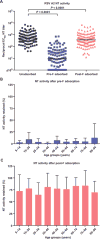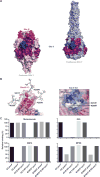Prefusion F-specific antibodies determine the magnitude of RSV neutralizing activity in human sera
- PMID: 26468324
- PMCID: PMC4672383
- DOI: 10.1126/scitranslmed.aac4241
Prefusion F-specific antibodies determine the magnitude of RSV neutralizing activity in human sera
Abstract
Respiratory syncytial virus (RSV) is estimated to claim more lives among infants <1 year old than any other single pathogen, except malaria, and poses a substantial global health burden. Viral entry is mediated by a type I fusion glycoprotein (F) that transitions from a metastable prefusion (pre-F) to a stable postfusion (post-F) trimer. A highly neutralization-sensitive epitope, antigenic site Ø, is found only on pre-F. We determined what fraction of neutralizing (NT) activity in human sera is dependent on antibodies specific for antigenic site Ø or other antigenic sites on F in healthy subjects from ages 7 to 93 years. Adsorption of individual sera with stabilized pre-F protein removed >90% of NT activity and depleted binding antibodies to both F conformations. In contrast, adsorption with post-F removed ~30% of NT activity, and binding antibodies to pre-F were retained. These findings were consistent across all age groups. Protein competition neutralization assays with pre-F mutants in which sites Ø or II were altered to knock out binding of antibodies to the corresponding sites showed that these sites accounted for ~35 and <10% of NT activity, respectively. Binding competition assays with monoclonal antibodies (mAbs) indicated that the amount of site Ø-specific antibodies correlated with NT activity, whereas the magnitude of binding competed by site II mAbs did not correlate with neutralization. Our results indicate that RSV NT activity in human sera is primarily derived from pre-F-specific antibodies, and therefore, inducing or boosting NT activity by vaccination will be facilitated by using pre-F antigens that preserve site Ø.
Copyright © 2015, American Association for the Advancement of Science.
Conflict of interest statement
Figures





Similar articles
-
Characterization of Epitope-Specific Anti-Respiratory Syncytial Virus (Anti-RSV) Antibody Responses after Natural Infection and after Vaccination with Formalin-Inactivated RSV.J Virol. 2016 Jun 10;90(13):5965-5977. doi: 10.1128/JVI.00235-16. Print 2016 Jul 1. J Virol. 2016. PMID: 27099320 Free PMC article.
-
Discovery of a Prefusion Respiratory Syncytial Virus F-Specific Monoclonal Antibody That Provides Greater In Vivo Protection than the Murine Precursor of Palivizumab.J Virol. 2017 Jul 12;91(15):e00176-17. doi: 10.1128/JVI.00176-17. Print 2017 Aug 1. J Virol. 2017. PMID: 28539438 Free PMC article.
-
A novel pre-fusion conformation-specific neutralizing epitope on the respiratory syncytial virus fusion protein.Nat Microbiol. 2017 Jan 30;2:16271. doi: 10.1038/nmicrobiol.2016.271. Nat Microbiol. 2017. PMID: 28134924 Free PMC article.
-
Neutralizing epitopes on the respiratory syncytial virus fusion glycoprotein.Curr Opin Virol. 2015 Apr;11:70-5. doi: 10.1016/j.coviro.2015.03.002. Epub 2015 Mar 26. Curr Opin Virol. 2015. PMID: 25819327 Free PMC article. Review.
-
Clinical Potential of Prefusion RSV F-specific Antibodies.Trends Microbiol. 2018 Mar;26(3):209-219. doi: 10.1016/j.tim.2017.09.009. Epub 2017 Oct 17. Trends Microbiol. 2018. PMID: 29054341 Review.
Cited by
-
Stability Characterization of a Vaccine Antigen Based on the Respiratory Syncytial Virus Fusion Glycoprotein.PLoS One. 2016 Oct 20;11(10):e0164789. doi: 10.1371/journal.pone.0164789. eCollection 2016. PLoS One. 2016. PMID: 27764150 Free PMC article.
-
A vulnerable, membrane-proximal site in human respiratory syncytial virus F revealed by a prefusion-specific single-domain antibody.J Virol. 2021 May 10;95(11):e02279-20. doi: 10.1128/JVI.02279-20. Epub 2021 Mar 10. J Virol. 2021. PMID: 33692208 Free PMC article.
-
Differences Between RSV A and RSV B Subgroups and Implications for Pharmaceutical Preventive Measures.Infect Dis Ther. 2024 Aug;13(8):1725-1742. doi: 10.1007/s40121-024-01012-2. Epub 2024 Jul 6. Infect Dis Ther. 2024. PMID: 38971918 Free PMC article. Review.
-
Phase 1/2a Safety and Immunogenicity of an Adenovirus 26 Vector Respiratory Syncytial Virus (RSV) Vaccine Encoding Prefusion F in Adults 18-50 Years and RSV-Seropositive Children 12-24 Months.J Infect Dis. 2022 Dec 28;227(1):71-82. doi: 10.1093/infdis/jiac407. J Infect Dis. 2022. PMID: 36259542 Free PMC article. Clinical Trial.
-
Antigenic Fingerprinting of Respiratory Syncytial Virus (RSV)-A-Infected Hematopoietic Cell Transplant Recipients Reveals Importance of Mucosal Anti-RSV G Antibodies in Control of RSV Infection in Humans.J Infect Dis. 2020 Feb 3;221(4):636-646. doi: 10.1093/infdis/jiz608. J Infect Dis. 2020. PMID: 31745552 Free PMC article.
References
-
- Glezen WP, Taber LH, Frank AL, Kasel JA. Risk of primary infection and reinfection with respiratory syncytial virus. Am J Dis Child. 1986;140:543–546. - PubMed
-
- Nair H, Nokes DJ, Gessner BD, Dherani M, Madhi SA, Singleton RJ, O’Brien KL, Roca A, Wright PF, Bruce N, Chandran A, Theodoratou E, Sutanto A, Sedyaningsih ER, Ngama M, Munywoki PK, Kartasasmita C, Simões EA, Rudan I, Weber MW, Campbell H. Global burden of acute lower respiratory infections due to respiratory syncytial virus in young children: A systematic review and meta-analysis. Lancet. 2010;375:1545–1555. - PMC - PubMed
-
- Anderson LJ. Respiratory syncytial virus vaccine development. Semin Immunol. 2013;25:160–171. - PubMed
-
- Caldera LJ, González-Reyes L, García-Barreno B, Wharton SA, Skehel JJ, Wiley DC, Melerob JA. Electron microscopy of the human respiratory syncytial virus fusion protein and complexes that it forms with monoclonal antibodies. Virology. 2000;271:122–131. - PubMed
Publication types
MeSH terms
Substances
Grants and funding
LinkOut - more resources
Full Text Sources
Other Literature Sources
Research Materials

